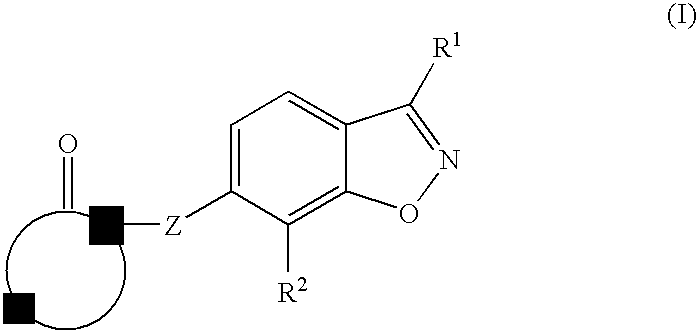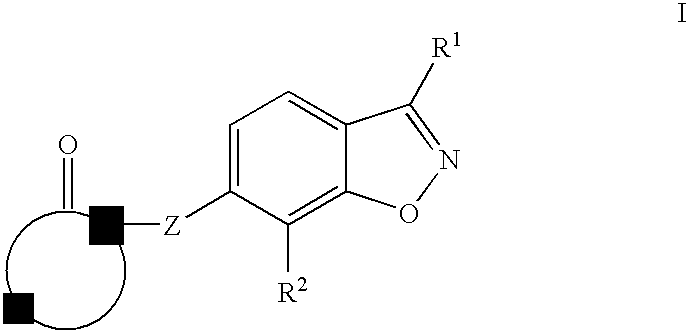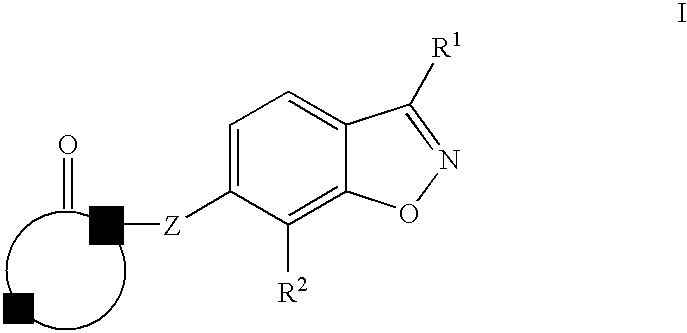Therapeutic compounds for treating dyslipidemic conditions
a dyslipidemic and therapeutic compound technology, applied in the field of therapeutic compounds for treating dyslipidemic conditions, to achieve the effects of preventing or reducing the risk of developing atherosclerosis, halting or slowing the progression of atherosclerotic disease, and removing cholesterol
- Summary
- Abstract
- Description
- Claims
- Application Information
AI Technical Summary
Benefits of technology
Problems solved by technology
Method used
Image
Examples
example 1
Radioligand Competition Binding Scintillation Proximity Assays
Preparation of Recombinant Human LXRα and LXRβ
[0357]Human LXRα and LXRβ were expressed as GST-fusion proteins in E. coli. The ligand binding domain cDNAs for human LXRα (amino acids 164–447) and human LXRβ (amino acids 149–455) were subcloned into the pGEX-KT expression vector (Pharmacia). E. coli containing the respective plasmids were propagated, induced, and harvested by centrifugation. The re-suspended pellet was broken in a French press and debris was removed by centrifugation. Recombinant human LXR receptors were purified by affinity chromatography on glutathione sepharose and receptor was eluted with glutathione. Glycerol was added to a final concentration of 50% to stabilize the receptor and aliquots were stored at −80° C.
Binding to LXRα:
[0358]For each assay, an aliquot of human GST-LXRα receptor was incubated in a final volume of 100 μl SPA buffer (10 mM Tris, pH 7.2, 1 mM EDTA, 10% glycerol, 10 mM Na molybdate, ...
example 2
Plasmids
[0361]Expression constructs were prepared by inserting the ligand binding domain (LBD) of human LXRα and LXRβ cDNAs adjacent to the yeast GAL4 transcription factor DNA binding domain (DBD) in the mammalian expression vector pcDNA3 to create pcDNA3-LXRα / GAL4 and pcDNA3-LXRβ / GAL4, respectively. The GAL4-responsive reporter construct, pUAS(5×)-tk-luc, contained 5 copies of the GAL4 response element placed adjacent to the thymidine kinase minimal promoter and the luciferase reporter gene. The transfection control vector, pEGPP-N1, contained the Green Fluorescence Protein (GFP) gene under the regulation of the cytomegalovirus promoter.
[0362]HEK-293 cells were seeded at 40,000 cells / well in 96 well plates in Dulbecco's modified Eagle medium (high glucose) containing 10% charcoal stripped fetal calf serum, 100 units / ml Penicillin G and 100 μg / ml Streptomycin sulfate at 37° C. in a humidified atmosphere of 5% CO2. After 24 h, transfections were performed wi...
example 3
[0364]To assess the relevant biological activity of the LXR agonists, certain compounds were tested for their ability to increase cholesterol efflux from cultured human cells, as described by Sparrow et al., JBC volume 277, pages 10021–10027, Mar. 22, 2002. Caco-2 cells, which are of human origin, were obtained from ATCC and grown in Opti-MEM (Gibco #51985-034) containing 10% FCS, non-essential amino acids (Gibco #11140-050), and vitamins (Gibco # 11120-052). Caco-2 cells were plated at 100,000 cells / well in 48-well plates. After four days the cells had reached confluence, and were then labeled with 3H-cholesterol by incubation for 24 hours in fresh growth media containing 3H-cholesterol (10 μCi / ml). Following labeling with 3H-cholesterol, cells were washed and incubated an additional 24 hours in serum-free media containing 1 mg / ml BSA, to allow for equilibration of 3H-cholesterol with intracellular cholesterol. Cholesterol efflux was initiated by adding 10 μg / ml apoA-I, with or wit...
PUM
| Property | Measurement | Unit |
|---|---|---|
| body weight | aaaaa | aaaaa |
| body weight | aaaaa | aaaaa |
| volume | aaaaa | aaaaa |
Abstract
Description
Claims
Application Information
 Login to View More
Login to View More - R&D
- Intellectual Property
- Life Sciences
- Materials
- Tech Scout
- Unparalleled Data Quality
- Higher Quality Content
- 60% Fewer Hallucinations
Browse by: Latest US Patents, China's latest patents, Technical Efficacy Thesaurus, Application Domain, Technology Topic, Popular Technical Reports.
© 2025 PatSnap. All rights reserved.Legal|Privacy policy|Modern Slavery Act Transparency Statement|Sitemap|About US| Contact US: help@patsnap.com



